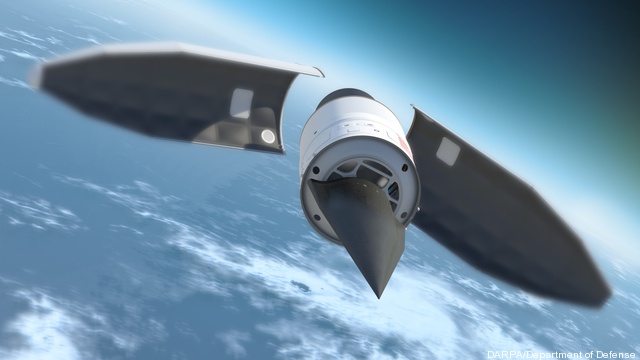DARPA Loses Contact With Hypersonic Weapon: Again
Posted on
 UPDATED Washington: DARPA, the Pentagon’s advanced weapons division, lost contact with a test version of a new weapon designed to hit any target around the world in less than an hour.
UPDATED Washington: DARPA, the Pentagon’s advanced weapons division, lost contact with a test version of a new weapon designed to hit any target around the world in less than an hour.
For more news and information on the swiftly-changing defense industry, please sign up for the Breaking Defense newsletter. You can also catch us on Twitter @BreakingDefense.
The Falcon Hypersonic Test Vehicle 2 test vehicle took off on top off an Air Force Minotaur IV rocket this morning at Vandenberg Air Force Base, Calif.
The rocket and its payload traveled successfully into the earth’s upper atmosphere, where the Falcon separated from the Minotaur, DARPA said.
Once separated, the Falcon should have glided through the atmosphere at nearly 13,000 miles per hour, while separate air, land and sea-based assets collected flight and performance data from the vehicle’s on-board systems.
But shortly after the Falcon began the glide phase of the test flight, DARPA officials say they lost contact with the vehicle.
During the first HVT-2 test flight, DARPA lost contact with the vehicle nine minutes into the flight and it crashed into the Pacific.
This time around, contact was maintained for “more than nine minutes” but the link was lost shortly thereafter, and the vehicle again crashed somewhere in the Pacific, according to a DARPA statement.
“We know how to insert the aircraft into atmospheric hypersonic flight. We do not yet know how to achieve the desired control during the aerodynamic phase of flight. It’s vexing; I’m confident there is a solution. We have to find it,” HVT-2 Program Manager Air Force Maj. Chris Schulz said.
DARPA has stood up an independent Engineering Review Board that will look into why the Falcon lost contact during the flight.
Today’s test flight was the final live demonstration scheduled for the Falcon vehicle, according to DARPA. “As today’s flight indicates, high-Mach flight in the atmosphere is virtually uncharted territory,” Schultz added.
The speeds and distances the Falcon is built to travel are critical to getting a conventional prompt global strike into the field, according to Pentagon officials.
Long championed by former Vice Chief of the Joint Chiefs of Staff Gen. Hoss Cartwright, the prompt global strike weapon is designed to hit targets anywhere in the world within an hour.
Cartwright championed the technology, arguing it would provide the United States more flexibility in responding to global crises, allowing the U.S. to rely on weapons that could be delivered to a remote area quickly without relying on nuclear weapons.
For some time it was touted as a weapon to use against high value targets such as the late Osama bin Laden. That use appears to fallen out of favor, largely because of the difficulties of getting excellent actionable intelligence with such a short timeframe.
UPDATED
Subscribe to our newsletter
Promotions, new products and sales. Directly to your inbox.
